1995 CADILLAC SEVILLE weight
[x] Cancel search: weightPage 104 of 410
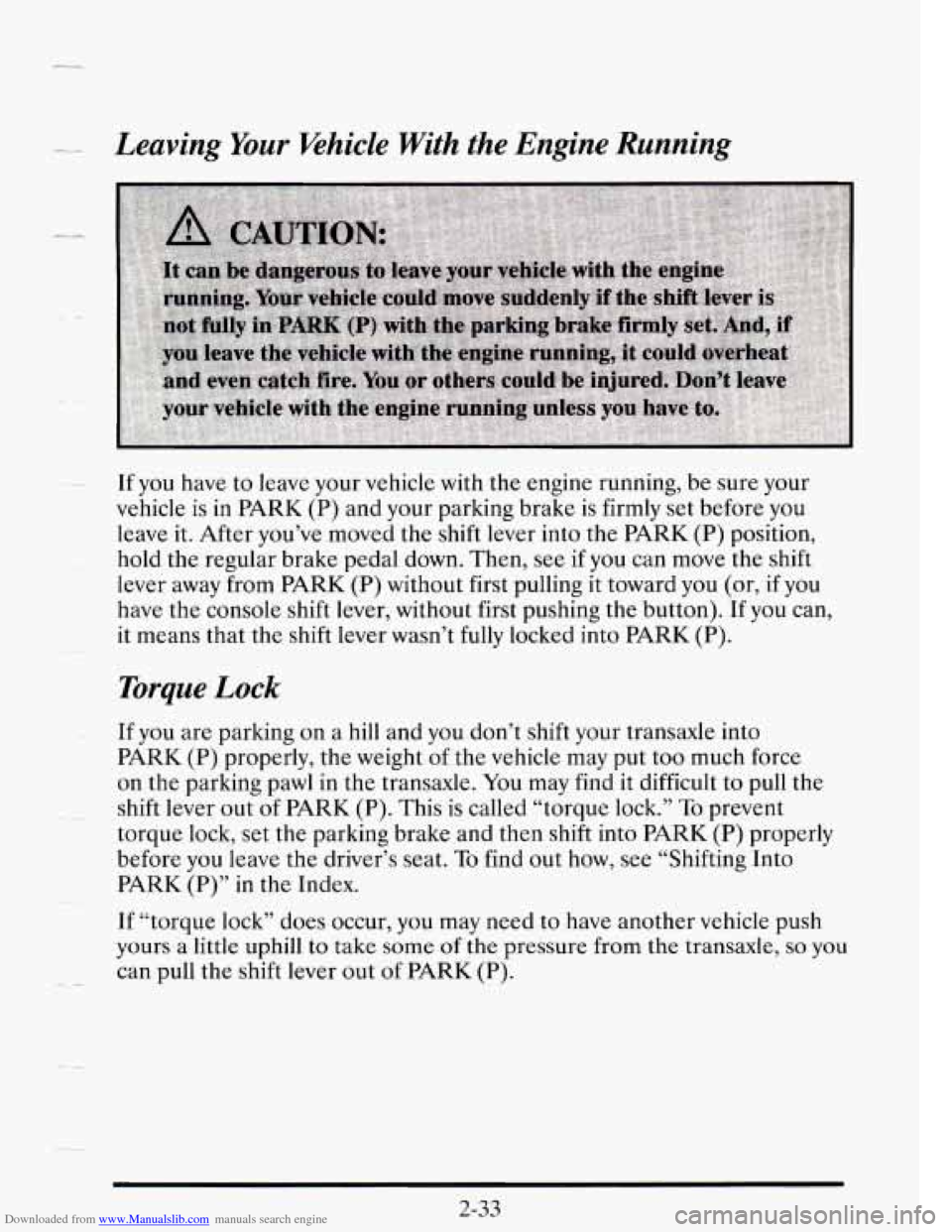
Downloaded from www.Manualslib.com manuals search engine -.- Leaving Your Vehicle With the Engine Running
If you have to leave your vehicle with the engine running, be sure your
vehicle
is in PARK (P) and your parking brake is firmly set before you
leave it. After you’ve moved the shift lever into the PARK (P) position,
hold the regular brake pedal down. Then, see
if you can move the shift
lever away from
PARK (P) without first pulling it toward you (or, if you
have the console shift lever, without first pushing the button). If you can,
it means that the shift lever wasn’t fully locked into
PARK (P).
Torque Lock
If you are parking on a hill and you don’t shift your transaxle into
PARK (P) properly, the weight of the vehicle may put too much force
on the parking pawl in the transaxle.
You may find it difficult to pull the
shift lever out
of PARK (P). This is called “torque lock.” To prevent
torque lock, set the parking brake and then shift into
PARK (P) properly
before you leave the driver’s seat.
To find out how, see “Shifting Into
PARK (P)” in the Index.
If “torque lock” does occur,
you may need to have another vehicle push
yours a little uphill
to take some of the pressure from the transaxle, so you
can pull the shift lever out of PARK (P).
2-33
Page 194 of 410
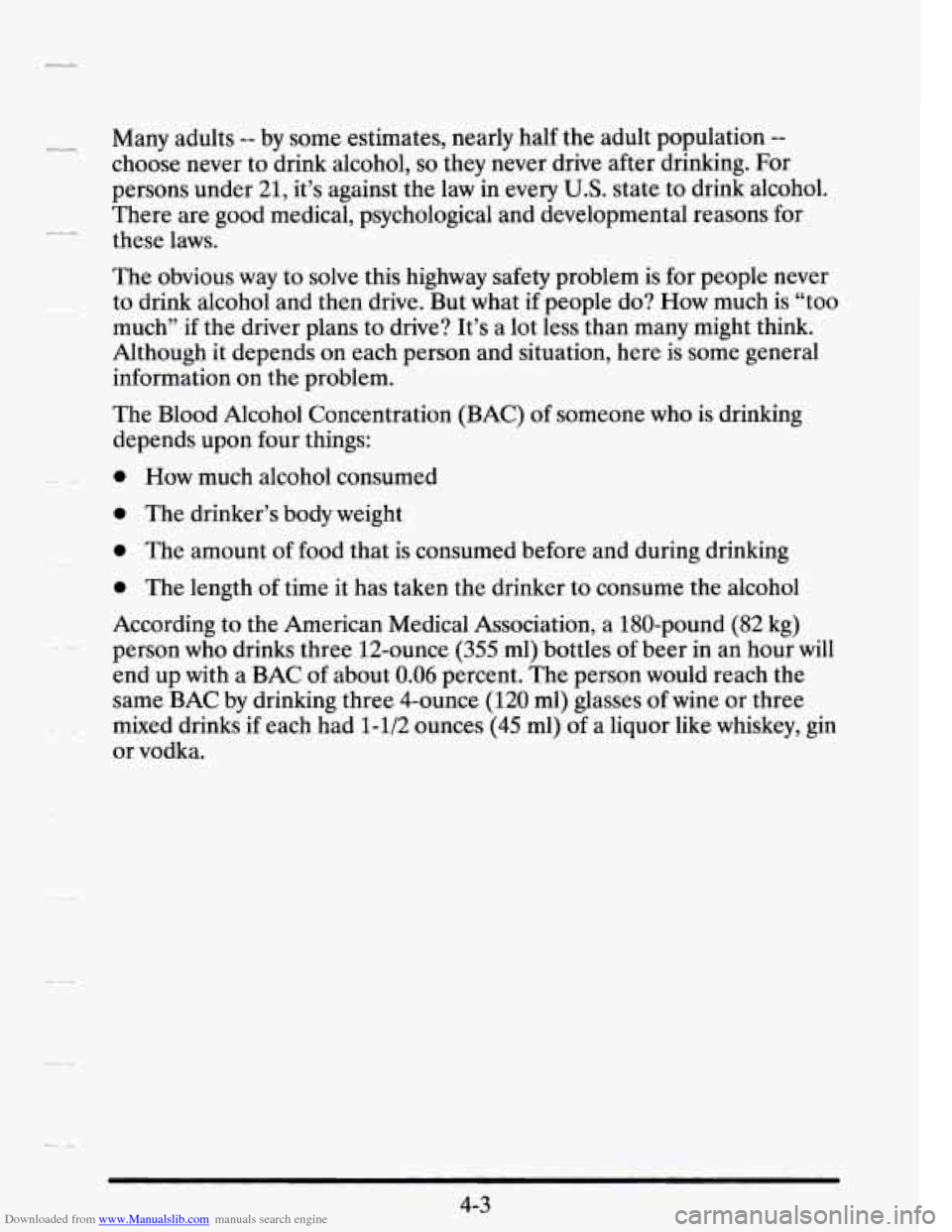
Downloaded from www.Manualslib.com manuals search engine Many adults -- by some estimates, nearly half the adult population --
choose never to drink alcohol, so they never drive after drinking. For
persons under 21, it’s against the law in every
U.S. state to drink alcohol.
There are good medical, psychological and developmental reasons for
these laws.
The obvious way to solve this highway safety problem is for people never
to drink alcohol and then drive. But what if people do? How much is “too
much” if the driver plans to drive? It’s a lot less than many might think.
Although it depends on each person and situation, here is some general
information
on the problem.
The Blood Alcohol Concentration (BAC)
of someone who is drinking
depends upon four things:
0 How much alcohol consumed
0 The drinker’s body weight
0 The amount of food that is consumed before and during drinking
0 The length of time it has taken the drinker to consume the alcohol
According to the American Medical Association, a 180-pound (82 kg)
person who drinks three 12-ounce (355 ml) bottles of beer in an hour will
end up with a
BAC of about 0.06 percent. The person would reach the
same BAC by drinking three 4-ounce (120 ml) glasses of wine or three
mixed drinks
if each had 1-1/2 ounces (45 ml) of a liquor like whiskey, gin
or vodka.
4-3
Page 195 of 410
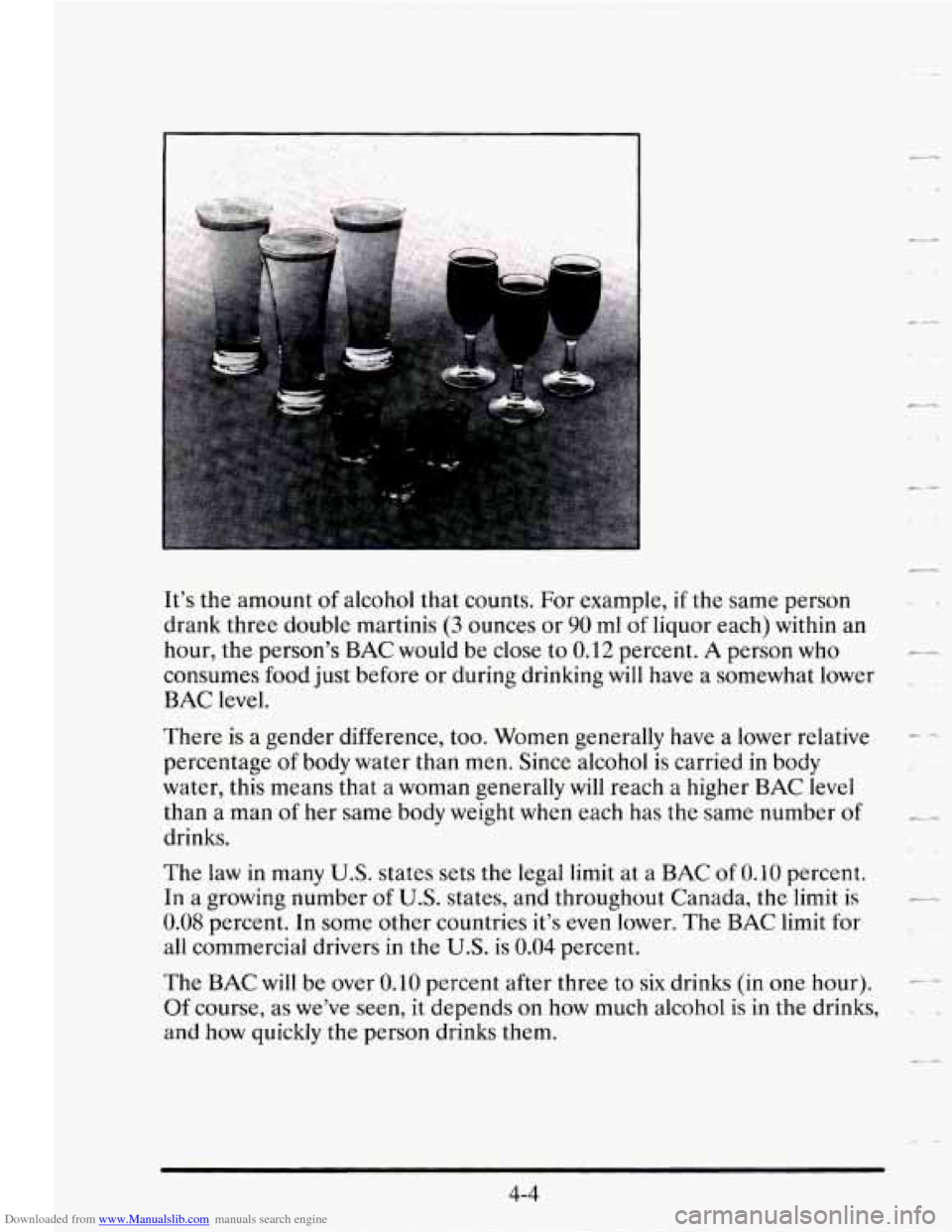
Downloaded from www.Manualslib.com manuals search engine It’s the amount of alcohol that counts. For example, if the same person
drank three double martinis
(3 ounces or 90 ml of liquor each) within an
hour, the person’s BAC would be
close to 0.12 percent. A person who
consumes food just before or during drinking will have a somewhat lower
BAC level.
There
is a gender difference, too. Women generally have a lower relative
percentage
of body water than men. Since alcohol is carried in body
water, this means that
a woman generally will reach a higher BAC level
than a man of her same body weight when each has the same number of
drinks.
The law in many
U.S. states sets the legal limit at a BAC of 0.10 percent.
In
a growing number of U.S. states, and throughout Canada, the limit is
0.08 percent. In some other countries it’s even lower. The BAC limit for
all commercial drivers in the U.S. is 0.04 percent.
The BAC will be over
0.10 percent after three to six drinks (in one hour).
Of course, as we’ve seen,
it depends on how much alcohol is in the drinks,
and how
quickly the person drinks them.
4-4
Page 228 of 410
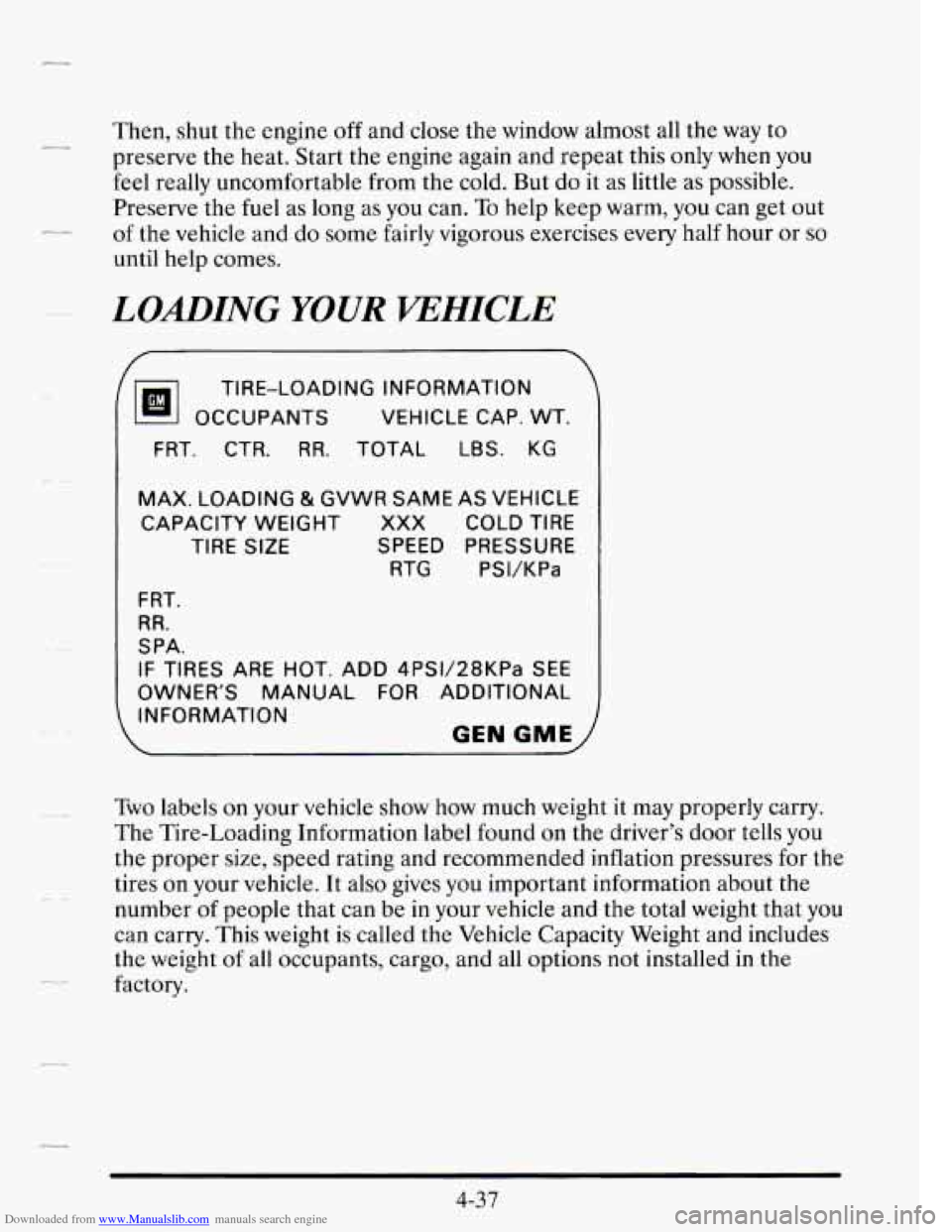
Downloaded from www.Manualslib.com manuals search engine -- -
Then, shut the engine off and close the window almost all the way to
preserve the heat. Start the engine again and repeat this only when you
feel really uncomfortable from the cold. But do it as little as possible.
Preserve
the fuel as long as you can. To help keep warm, you can get out
of the vehicle and do some fairly vigorous exercises every half hour or so
until help comes.
LOADING YOUR VEHICLE
OCCUPANTS VEHICLE
CAP. WT.
TIRE-LOADING INFORMATION
FRT. CTR.
RR. TOTAL LBS. KG
MAX. LOADING
& GVWR SAME AS VEHICLE
CAPACITY WEIGHT XXX COLD TIRE
TIRE
SIZE SPEED PRESSURE RTG PSVKPa
F RT.
RR.
SPA.
IF TIRES ARE
HOT. ADD 4PSV28KPa SEE
OWNER'S MANUAL FOR ADDITIONAL
INFORMATION
GEN GME 1
Two labels on your vehicle show how much weight it may properly carry.
The Tire-Loading Information label found
on the driver's door tells you
the proper size, speed rating and recommended inflation pressures for the
tires on your vehicle. It also gives you important information about the
number
of people that can be in your vehicle and the total weight that you
can carry. This weight is called the Vehicle Capacity Weight and includes
the weight of all occupants, cargo, and all options
not installed in the
factory.
4-37
Page 229 of 410
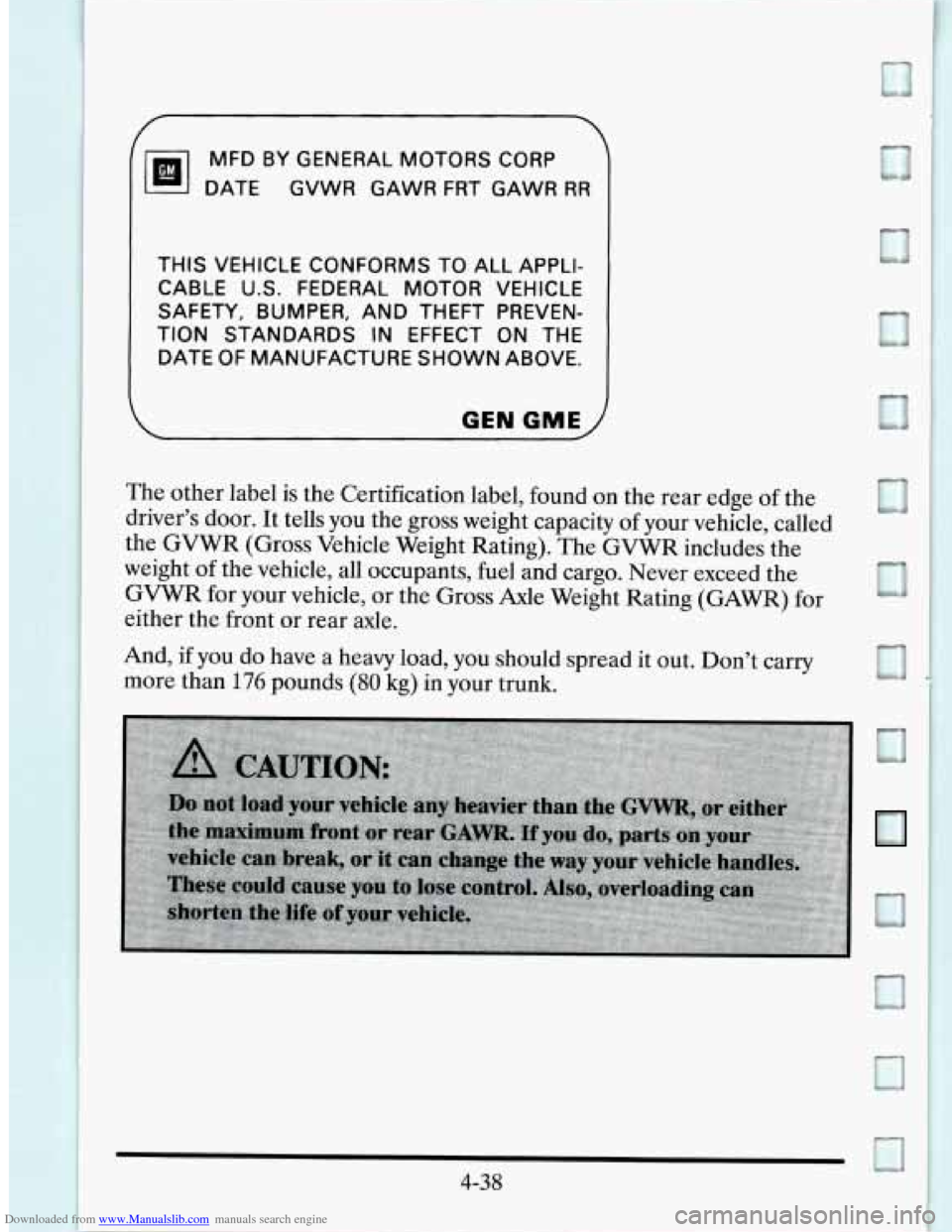
Downloaded from www.Manualslib.com manuals search engine MFD BY GENERAL MOTORS CORP
DATE GVWR GAWR FRT GAWR
RR
THIS VEHICLE CONFORMS TO ALL APPLI-
CABLE U.S. FEDERAL MOTOR VEHICLE
TION STANDARDS
IN EFFECT ON THE
DATE OF MANUFACTURE SHOWN ABOVE.
SAFETY, BUMPER,
AND THEFT PREVEN-
The other label is the Certification label, found on the rear edge of the
driver’s door. It tells you the gross weight capacity of your vehicle, called
the GVWR (Gross Vehicle Weight Rating). The GVWR includes the
weight
of the vehicle, all occupants, fuel and cargo. Never exceed the
GVWR for your vehicle, or the Gross Axle Weight Rating (GAWR) for
either the front or rear axle.
And,
if you do have a heavy load, you should spread it out. Don’t carry
more than
176 pounds (80 kg) in your trunk.
4-38
c3
n
n
n
n
a
Page 231 of 410
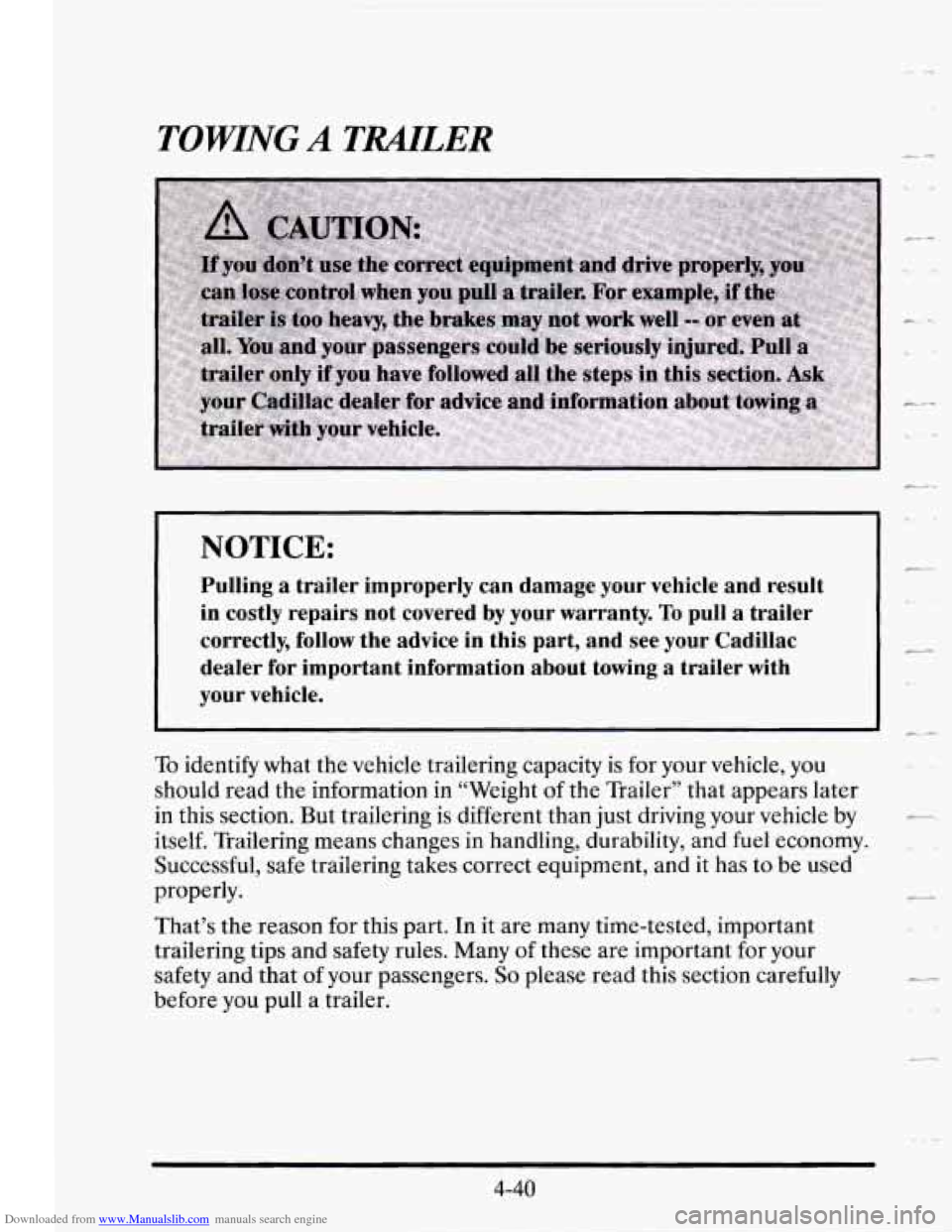
Downloaded from www.Manualslib.com manuals search engine TOWING A TMLER c-
NOTICE:
Pulling a trailer improperly can damage your vehicle and result
in costly repairs not covered by your warranty. To pull a trailer
correctly, follow the advice
in this part, and see your Cadillac
dealer for important information about towing a trailer with
your vehicle.
To identify what the vehicle trailering capacity is for your vehicle, you
should read the information in “Weight
of the Trailer” that appears later
in this section. But trailering
is different than just driving your vehicle by
itself. Trailering means changes in handling, durability, and fuel economy.
Successful, safe trailering takes correct equipment, and it has
to be used
properly.
That’s the reason for this part.
In it are many time-tested, important
trailering tips and safety rules. Many
of these are important for your
safety and that
of your passengers. So please read this section carefully
before you pull
a trailer.
4-40
c-
Page 232 of 410
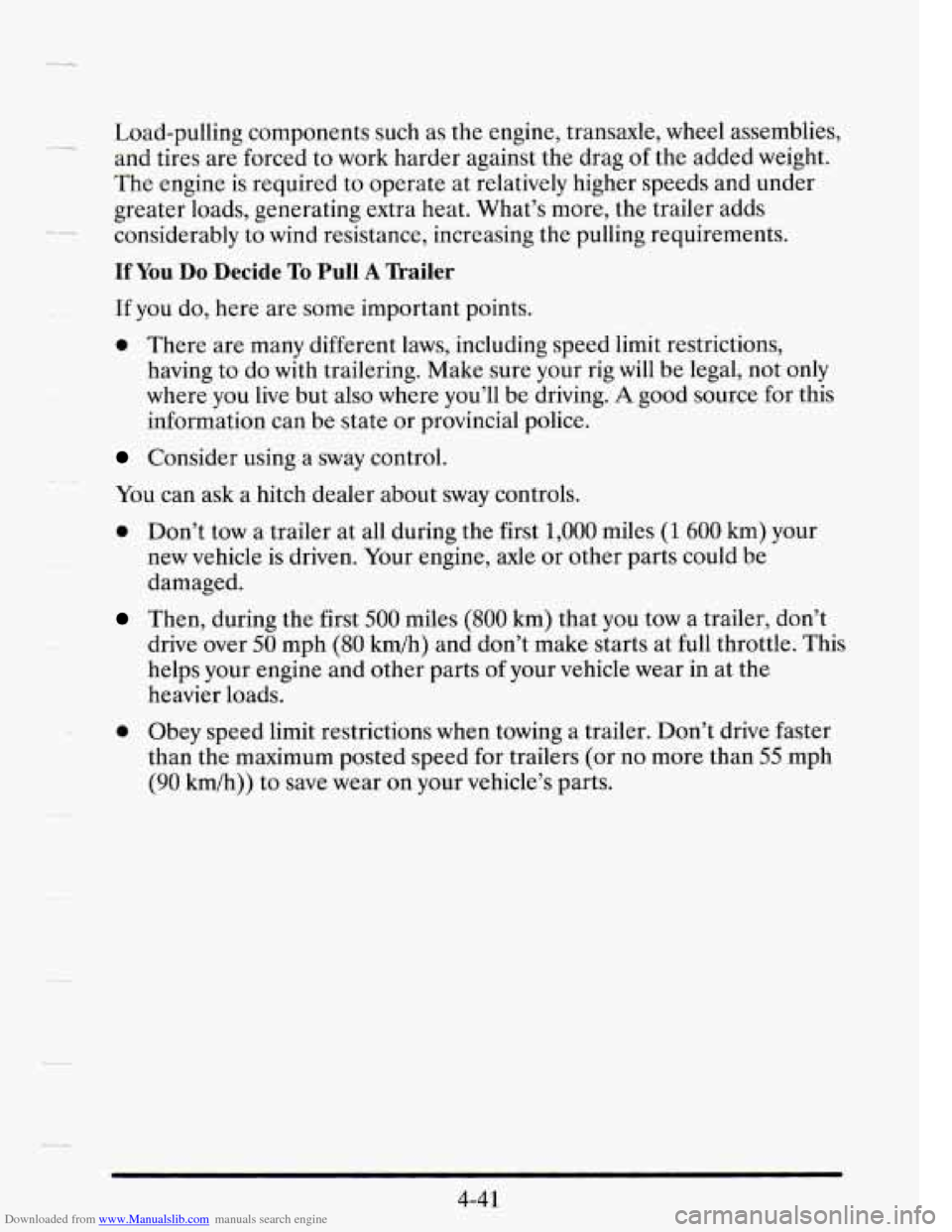
Downloaded from www.Manualslib.com manuals search engine Load-pulling components such as the engine, transaxle, wheel assemblies,
and tires are forced to work harder against the drag
of the added weight.
The engine is required to operate at relatively higher speeds and under
greater loads, generating extra heat. What’s more, the trailer adds
considerably to wind resistance, increasing the pulling requirements.
If You Do Decide To Pull A mailer
If you do, here are some important points.
0 There are many different laws, including speed limit restrictions,
having
to do with trailering. Make sure your rig will be legal, not only
where you live but also where you’ll be driving.
A good source for this
information can be state or provincial police.
Consider using a sway control.
You can ask a hitch dealer about sway controls.
0 Don’t tow a trailer at all during the first 1,000 miles (1 600 km) your
new vehicle is driven. Your engine, axle
or other parts could be
damaged.
Then, during the first 500 miles (800 km) that you tow a trailer, don’t
drive over
50 mph (80 km/h) and don’t make starts at full throttle. This
helps your engine and other parts
of your vehicle wear in at the
heavier loads.
0 Obey speed limit restrictions when towing a trailer. Don’t drive faster
than the maximum posted speed for trailers
(or no more than 55 mph
(90 km/h)) to save wear on your vehicle’s parts.
4-4 1
Page 233 of 410
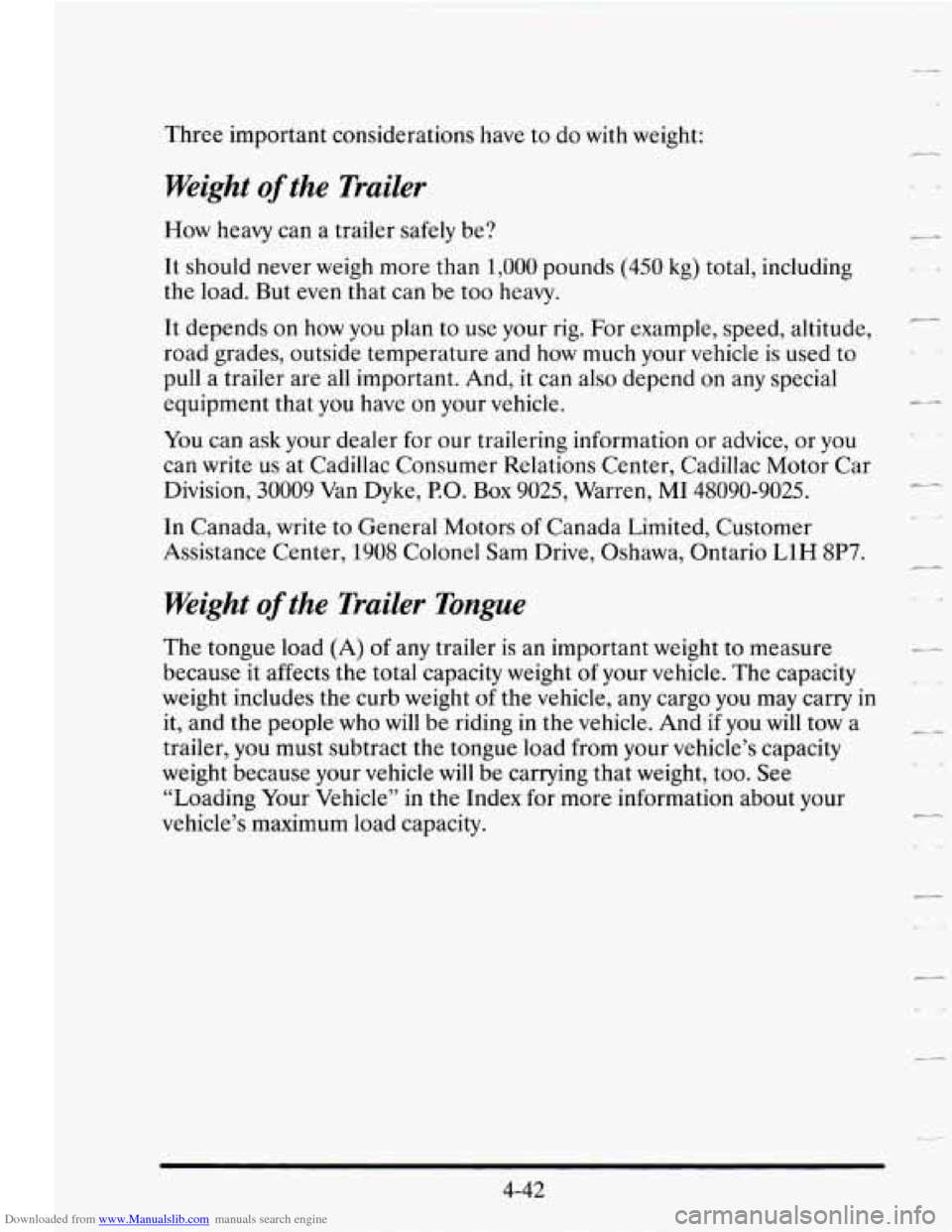
Downloaded from www.Manualslib.com manuals search engine Three important considerations have to do with weight:
Weight of the Trailer
How heavy can a trailer safely be?
It should never weigh more than
1,000 pounds (450 kg) total, including
the load. But even that can be too heavy.
It depends
on how you plan to use your rig. For example, speed, altitude,
road grades, outside temperature and how much your vehicle is used
to
pull a trailer are all important. And, it can also depend on any special
equipment that
you have on your vehicle.
You can ask your dealer for our trailering information or advice, or you
can write us at Cadillac Consumer Relations Center, Cadillac Motor Car
Division, 30009 Van Dyke,
EO. Box 9025, Warren, MI 48090-9025.
In Canada, write to General Motors
of Canada Limited, Customer
Assistance Center, 1908 Colonel Sam Drive, Oshawa, Ontario
L1H 8P7.
Weight of the Trailer Tongue
The tongue load (A) of any trailer is an important weight to measure
because it affects the total capacity weight of your vehicle. The capacity
weight includes the curb weight
of the vehicle, any cargo you may carry in
it, and the people who will be riding in the vehicle. And if you will tow a
trailer, you must subtract the tongue load from your vehicle’s capacity
weight because your vehicle
will be carrying that weight, too. See
“Loading Your Vehicle” in the Index for more information about your
vehicle’s maximum load capacity.
4-42
Ic-r
L